Thursday morning, with the heatwave back on the rise, we returned to the boat on her temporary mooring at Harefield Marina. Another successful trip via public transport & taxi so maybe it can work. A stop at Tesco in Gerrards Cross on the way to get essential supplies and back on board by lunchtime. Plenty to do to get the running gear back in place and sort things out during the afternoon. We had also decided it was time to put some water cleanser in the tank, which just meant adding the tablets, filling the tank and waiting for the tablets to do their work.
As we were heading out into the Thames soon we would need an anchor available. We have got one but have had no need to put it together up to now so this was a chance to get it all out of the locker, lay it out on the bank and work out what we’ve got and how it works. 80 feet of rope, 25 feet of heavy chain, 3 metal shackles and one lump of heavy metal with pivoting flukes marked 16 kg. Think we have worked it out – Anchor, shackled to chain, shackled to rope with a bare end to tie onto a round metal fixing point we have screwed into forward bulkhead on the starboard side of the bow. A couple of days intense practice tying an ‘anchor hitch’ would ensure that we can put it together, secure it and have it ready to hand before we go through the Thames Locks. Hopefully, we should never have to find out how successfully we have done it.
With the temperature up at 30°C again all this was warm work and we were forced to repair again to the Bear on the Barge for a couple of cold beers before dinner.
We both found the broken-down marina (I used to have one of those as a company car in the ’70s) a bit depressing so on Friday morning it was good to get the engine started and cast off. We didn’t go too far at first but a faultless reverse pirouette and an elegant sideways chassé onto the fuel dock boded well. With a full tank, a replacement gas bottle in exchange for the empty and the mooring fees paid up we set off down through Uxbridge on long, straight sections of canal that seemed unnaturally wide to us. Lots more moored boats but occasional spaces among them. We weren’t planning to go far, just four miles through three locks on another very hot day. We found a spot under a shady tree a little short of Cowley Lock and just behind the long term moorings. Having stopped there for lunch we decided that it was probably as good a mooring as we would find the other side of the lock and we might as well stop where we were.
Stopping at lunchtime gave us a chance to walk down the canal and recce ahead and to explore a bit of Yiewsley (we’d never heard of it either). New flats built overlooking the canal, opposite a large Tesco, reminded me of nothing so much as a set of barrack blocks on an army garrison. Yiewsley itself was a typical busy High Street but we came back along a section of the Colne Valley trail across the Slough Arm, through a bit of Little Britain, Cowley Lake & Huntsmoor Park. Having crossed over the canal and river the park and nature reserve were pleasantly shaded, fairly deserted and surprisingly free of rubbish and discarded shopping trolleys etc. Our route brought us back up Mill Lane, where we found the water mill had been developed rather impressively. Then to the Malt Shovel, a Mitchell & Butler pub but well run and offering vital refreshment.
When we had stopped initially we met a man and three dogs who had a long term mooring there. He told us about the gypsies who had just occupied vacant office units on the offside and the other side of some long term moorings there. Shortly after we arrived back there was a loud bang that was never explained. The ‘travellers’ emerged and seemed to blame a quite innocuous man from the narrowboat ‘Martini’ who had created a lovely little plot there and clearly had nothing to do with it. There was a lot of shouting and under the violence of this abuse it was no surprise that Martini man moved his boat up a few berths. It seems outrageous that he should have to feel so threatened on his own plot but you hear these stories up and down the country. For most of the evening we could hear tipper trucks and vans arriving and fly-tipping in the car parks of the offices. We were told they made so much mess they actually blocked their own vehicles in. A slightly nervous night ensued but as we were on the opposite side of the canal and beside a plant hire depot flooded with security lights and CCTV we didn’t feel too concerned.
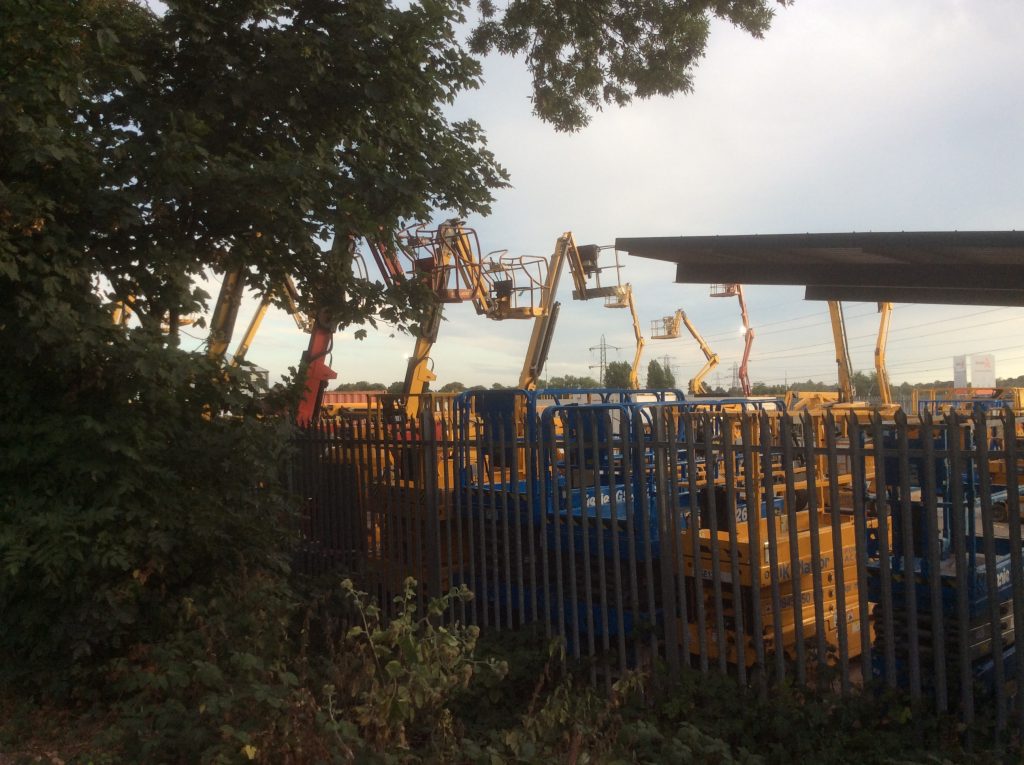
Plant Hire Centre – Standing Guard
Saturday morning and we set off to go through Cowley Lock for a six mile lock-free stretch down to Southall. The start of the day was very congested with moored boats but it cleared after about a mile and we could start to move a little faster. Past West Drayton station everything around us seemed to become a lot meaner and more crammed together. The day before, we had passed large detached and semi-detached houses, all extended in different ways but the end result looking like homes. Here there were ramshackle additions to tiny houses and converted garages right up against the canal that looked much more like attempts to build extra rooms with little or no facilities or services and to rent them out as ‘flats’. In keeping with this the amount of household rubbish floating in the water increased dramatically. Algae was forming like a furry green carpet right across the canal, just thick enough to support the weight of discarded packets and bottles, which made it look even worse.
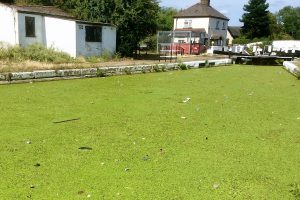
Rubbish Sitting On Top Of Algae

Having passed the Bull’s Bridge (where we had been counselled not to moor) and the Paddington Arm, we could still find areas that had pleasantly developed and landscaped canal-side walks and we found a shady spot just past the two Norwood locks where we could moor for the evening.
While Sue settled in I went for a walk down the towpath and along the Hanwell flight. I found quite a lot of information there. I had never heard of Three Bridges except in West Sussex but here our old friend Isambard Kingdom Brunel had been brought in to work out how to take a new railway across a main road and the existing canal. It seems he brought it through a cutting below the point where a road bridge crossed the existing canal and put the canal itself into an iron trough above the rail route. It is quite impressive when you actually look at it.
I also learned a bit about the Ealing hospital, whose forbidding wall lines the towpath beside the locks. There are four small, square recesses in the wall that are weakened and designed to be knocked through by the fire brigade if they need to put hoses through the wall to get water from the canal to fight a blaze.
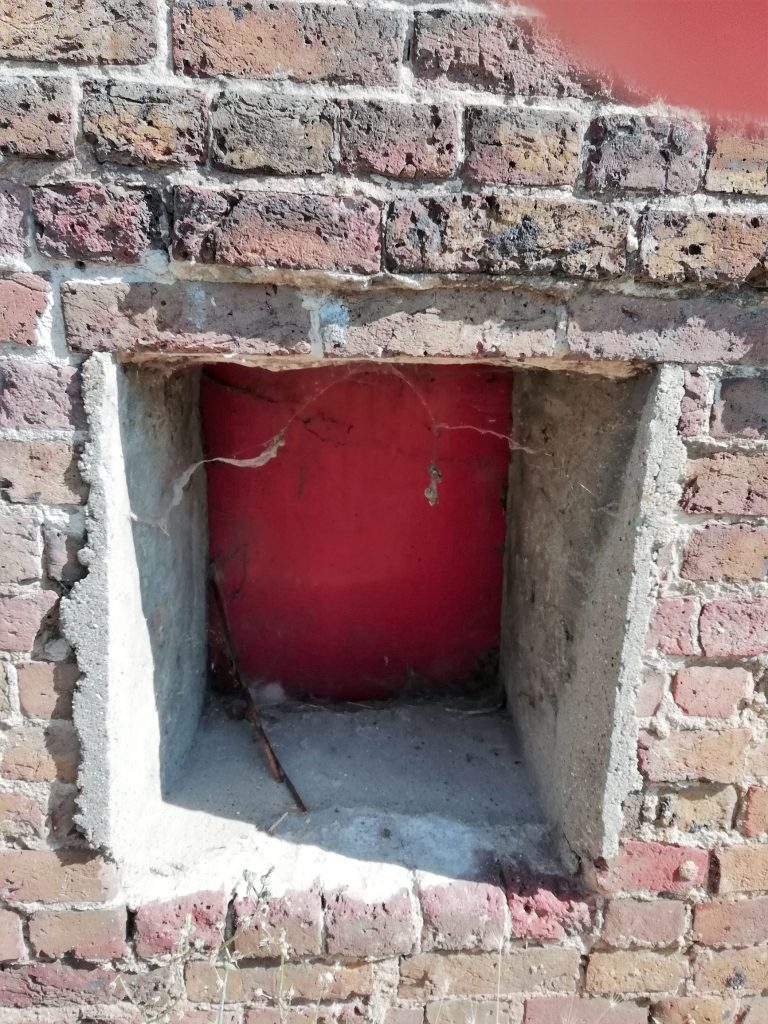
Firehose Holes
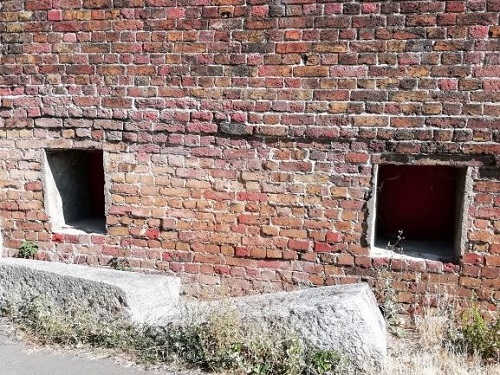
Firehose Holes
A fairly roughly bricked in arch between two of the locks once gave access to boats bringing in coal and collecting excess produce from the Hospital’s market garden for sale. You can see that the pound here is wider and would allow the boats to turn in or out of the entrance.
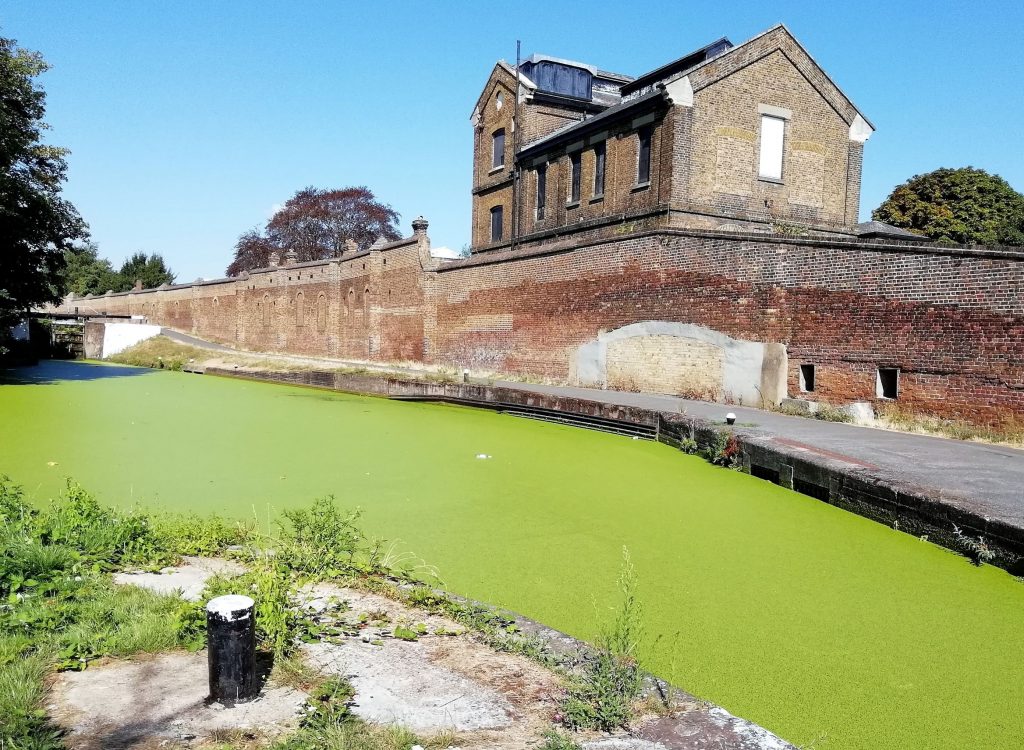
One-Time Boat Entrance to Ealing Hospital
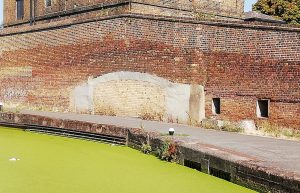
A little further down there are steps built under the water coming up to the level of the side. Apparently the jostle of boats was so busy here that some horses would be dragged in to the lock or pound to ‘take a look’. These steps were designed to make it easier to get them out.

Horse Stair in the Lock
Turning away from the canal on the way back I found myself in a small estate of new houses. I could hear a frantic knocking on one of the front windows and a woman shouting “Help”, “Could you please help me”, “Help, please” etc. I approached the house with some trepidation as to what it could be about. It transpired that in visiting her daughter’s house while she was away, she had managed to lock herself in somehow. It seemed odd but as she was already inside the house there seemed no harm in taking the keys through the window and opening the front door.
Carrying on across the locks there is a very large open area running parallel to them with no signage and quite hidden away. Quite a little haven from all the urban development round it. Suddenly I could see the shapes of cattle across the field. On inspection it was the wooden statues of two sheep, just standing in the middle of the field. No explanation of who had carved them or put them there or why.
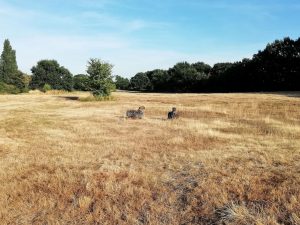
Mysterious Carved Sheep
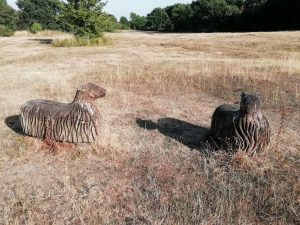
Returning to the boat I was just about to pour a G&T when I could hear a very loud crackling noise. There was no sign of it and no smell at first but it sounded just like a fierce fire. Sure enough the dried grass in the open land just the other side of the hedge was alight. It took hold very quickly and spread like, well . . . wildfire. A fisherman nearby had already called it in so we got everything on board in case we had to move and waited to see how it developed. The brigade arrived quickly and got it under control in an hour or so. It did come right into the hedge beside the boats moored there but was extinguished in time to avoid anyone having to pull their pins and move away.
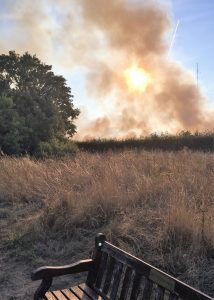
Bush Fire Beside the Boats

We moved on down the Hanwell flight on Sunday morning. All went well through locks 92 to 96. I did spot a broken propeller propped up on some sluice controls, suggesting someone had had a very bad day yesterday but on closer inspection it turned out to be a sculpture, complete with brass plaque.
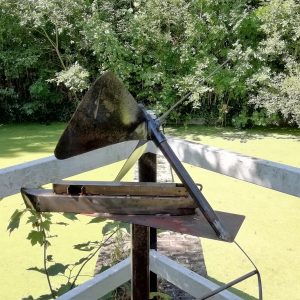
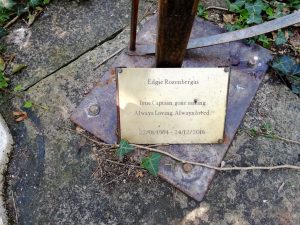
At lock 97, however, I had one of my falls. Watching a dog that looked about to plunge in I put my whole weight into thin air and managed to gash in the other leg as I went down. I have to stop doing this! This time, as it was still bleeding 6 hours later, we had to walk to the nearest Urgent Care Centre and wait 2½ hours to get a new dressing for it.
On the way to the Hospital (sort of) we did a recce of the two remaining locks before the Thames, the Brentford Gauging Locks and the Thames Locks. They are big electrically operated sluices and gates but the first ones you can operate by yourself. The Thames Lock has to be done by a Lockkeeper and only operates around the high tide times. There is a lot of advice about how to negotiate these locks and the Thames, the equipment you must have, the people you must notify and the signs you must obey etc. etc. etc. Much of it is conflicting or confusing so we had planned to suss all this out on Monday and go down on Tuesday. On site, however, it looked pretty simple and there was no queue waiting to go out of the Thames Lock. After a brief call to the PLA to check on something and looking at where we would have to spend the extra day we decided to come up to the Thames Lock tonight and try and go through with the tide at 09:00 on Monday morning.
By the time we got back to the boat it was 19:30. We pulled on to the service dock just before the gauging locks to make sure we didn’t need to stop again too soon. We also needed to prepare our anchor. Unfortunately, from there, you can’t quite see the locks themselves. The plan was for me to go up to the locks, open one side and call Sue up on our 2-way radios to tell her to come ahead. I got to the locks and called Sue to say I would open the left hand lock. I then tried to operate the left hand lock, which didn’t work at all. I tried the right hand lock and that was fine. Now to call Sue and tell her we had switched sides and to come ahead. At that point the radio battery died. The lock was open but Sue couldn’t see it and I couldn’t tell her. Nothing for it but to climb up onto the bridge over the locks, walk all the way round to the far side and try to attract her attention with some exaggerated arm waving. Fine entertainment for the guests at a wedding reception going on in the Holiday Inn next to the lock and the many sunny Sunday evening gongoozlers strolling around it. However, she got the message and the rest of the operation went fairly smoothly so we finally got to the Thames Locks, tied up and put the dinner on about 21:00. Quite a tiring day.
One piece of advice offered was that, as the section by the Thames Lock is “semi-tidal” you should leave slack mooring lines to cater for the rise and fall. How slack is slack? How much does it rise and fall? The tide tables say it may be 5-6 Metres. We had arrived at high tide and low tide wouldn’t be until 04:30. I fastened the lines with a lot of slack and set the alarm for 03:00 to be able to check that it wasn’t becoming a problem, which at that point it clearly wasn’t. When we went up to report to the lockkeeper at 08:00 next morning I asked him how much it did fluctuate this side of the lock. About 1 metre or so apparently. Another wasted night of restless worry.
As we had really expected all along we found that, despite all the mystique, the whole process of passing in and out of the tidal Thames was very straightforward or even pretty casual. It is a bit more stringent if you turn left and head for Limehouse, I gather but we’ll find out about that another time. In foul weather and high winds it might also be different but on a shiny, sunny, summer’s morning, Brentford and Teddington were simple and not prescriptive at all. Being on the river was quite exciting at first. We weren’t sure how the narrowboat would react to the wash from large cruisers all racing downstream in a convoy. Everything feels on a larger scale, which means more room to make mistakes in and more uncertainty about which way to go. There is also the difference of being able to double your speed to 8 knots and milk a few more revs out of the engine than usual. It all felt quite exhilarating, although the man in the street might wonder what all the fuss was about.
From Teddington we headed up towards Kingston by about midday and found a mooring, free for 24 hours, just outside John Lewis. The only snag was that the dock was a foot higher than the roof of the boat, so a bit of a scramble to get on and off, particularly for Sue. Still, John Lewis! Nothing could hold her back! Truly, John Lewis are certainly missing the guiding hand of Andy Street. I don’t know what he had but it permeated the store and its quality. Based on the Kingston offering they need to be looking over their shoulder at the spectres of Woolworths and BHS.
That was it for the day. We’d started far too early, the weekend had been far too stressful and the weather was far too hot for us to want to do much more. We spent the afternoon ¼ mile away in Canbury Gardens soaking up the breeze in the shade there, indulging in an ice-cream, moving on to The Bishop for a large VAT and a couple of pints of Peroni and returning to the boat, very carefully, for dinner al fresco, as the cabin was still sweltering from the afternoon sun. It was fascinating to watch all the activity on the river. So many different kinds of craft. Powered, un-powered, underpowered. Moving in all directions for all sorts of reasons. Paddleboards up against paddle steamers. Single sculls and coxless pairs. Fours and Eights. Eighteen and a cox we saw in one boat. Skiffs, dinghies, inflatables, cruisers, gin palaces, speed boats, all moving at a rate that feels unseemly to those accustomed to canal time. The wide-beams we moan about on the cut are lost in insignificance on the river and narrowboats are a very small minority population. Josh Mcrae’s ‘Messing about on the River’ was written for this scene.
Tuesday morning, following another stern talking-to for the filter in the shower pump, we scrambled over the roof and embarked on a heritage trail of Kingston Upon Thames supplied through the local council website. Apart from a little local difficulty locating the right jumping-off point it was an interesting couple of hours in the blistering heat, providing too much information to fully absorb but intriguing snippets along the way. A short visit to Sainsbury’s to enjoy their air-conditioning and we returned to the boat in time for lunch. First, though, we engaged drive at the newly discovered warp factor 8 knots and moved through the bridge, across the river and 400 yards downstream to a new 24 hour mooring on Barge Walk, in the grounds of Hampton Court Palace. Cruising done for the day!
In the afternoon I left Sue studying the latest edition of Waterways World and set off in search of Bushey Park. A lot of this trip will be about places we’ve heard of and always driven past but never actually visited. Bushey Park is huge and full of wildlife. You are asked not to approach within 50 metres of the deer. Based on the experience today it is hard to get more than 5 metres away from one. People were mingling with herds of 12-20 roe deer, many with full racks of antlers.
I returned via Home Park, where there were a lot more fallow deer around and a lot fewer people. At the exit gate was a history of Home Park with a brief rundown of how it changed through the descent of kings and queens from the time Henry VIII first fenced it in. I liked the fact that Queen Anne took the throne and pursued a keen interest in riding & hunting in the park but “as she grew stouter” she would hunt from her carriage and rides were created across it so that she could keep up with the chase. This was after William III died following a fall from his horse in 1702. One thing that reading this potted history made me realise was how little we were taught in history at school about the 18th and 19th centuries. There seemed to be a sudden giant leap from the Glorious Revolution to the causes of the First World War with very little substance on the spaces in between.
A few drops of rain and one clap of thunder didn’t really constitute a break in the weather but the accompanying cloud cover took the edge off the heat of the sun for a while. On the return trip the clouds cleared, the heat returned at full force and we were obliged to repair to the White Hart Hotel in Hampton Wick for some refreshment before dinner.
The washing machine on board takes about half a normal load, I am told. It can only be run while the engine is on or it will drain the batteries. That doesn’t work well when we expect to spend time ashore so on Wednesday morning the decision was made to take the heavier washing, like towels, to a local laundrette for a service wash before moving on. It was a 20 minute walk each way to the laundrette and the wash would take 2 hours. Thus Wednesday was declared a shopping morning. There was an underlying, running theme of finding a birthday present for my mother but we looked at a lot of other stuff on the way and couldn’t resist indulging in the street food on sale in Market Place for lunch. Truly excellent and good value compared to yesterday’s soggy Sainsbury’s sandwich.
One thing we acquired was an Oyster Card. When I had suggested to Sue that we hop on a bus to get to the hospital the other day I was astonished to hear that I couldn’t do that because they won’t accept cash for the fare. I confess I am still struggling with the loss of the Routemaster and the fact that I can no longer board a bus by grabbing the pole and jumping on the platform as it rounds a corner. This latest revelation was absolutely gobsmacking! Still you can’t hold back the tide, so it seems I must now add this Oyster Card to my Senior Railcard, just in case we do need to catch a bus.
Laundry collected, we made it back to the boat just in time for the expiry of our free 24 hour mooring and raced (well, it seems that way to us) upstream towards Hampton Court Palace. A bit more of a breeze today which made it seem even more exhilarating. We found the one remaining space at the 24 hour free mooring right outside the palace gates and in sight of Hampton Court Bridge. At 35 minutes, total, it seems we are getting in to the swing of the slowing down thing and this was a cruise worthy of Neil Payne.
Time in the afternoon for a stroll through the palace grounds to Bushey Park again so that Sue could meet the deer there. A cup of tea watching the wildlife and back to the mooring for a G&T or a glass of Pimms in the evening sun. It’s a gruelling life for the homeless traveller in London

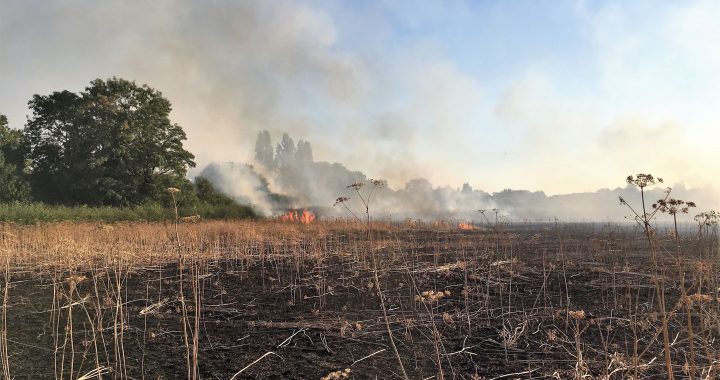

Very entertaining… would be interesting to see a map of these travels… are you tracing your route?
I really thought I had suppressed the ability to comment, so I hadn’t been watching for them. I clearly have a lot to learn 🙂 I’m not doing that at the moment but it is a good idea. I’ll have to have a think about how best to do it – watch this space!